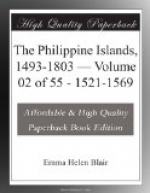[73] This chief’s name is also spelled in this relation Mahomat.
[74] The fanega is a measure of capacity that was extensively used throughout Spain and the Spanish colonies, and in the Spanish-American republics; but it is now largely superseded by the measures of the metric system. Its value varied in different provinces or colonies. Its equivalents in United States (Winchester) bushels are as follows: Aragon, O.64021; Teruel (Aragon), I.23217; Castile, 1.59914; Asturias, 2.07358; Buenos Aires, 3.74988; Canary Islands, 1.77679 (struck), 2.5 (heaped). The fanega of Castile is equivalent to 5.63 decaliters. The name was also applied to the portion of ground which might be sown with a fanega of grain.
[75] A detailed relation of the voyage of the “San Geronimo” was written by Juan Martinez, a soldier, being dated Cebu, July 25, 1567. It is given in Col. doc. ined. Ultramar, ii, no. 47, pp. 371-475. From the very first the insubordination of the pilot Lope Martin was manifest, who said to the easy-going captain. “If you think you are going to take me to Cebu, you are very much mistaken; for as soon as he saw me there, the governor would hang me.”
[76] In regard to this use of precious gums, see East Africa and Malabar (Hakluyt Society Publications, no. 35), pp. 31, 230; in that text yncenso is incorrectly translated “wormwood.”
[77] Document no. xli, pp. 244-276, tomo iii, consists of memoranda made by Hernando Riquel, notary of the expedition. These were drawn up by order of Legazpi, and relate to occurrences after the fleet reached Cabalian (March, 1565), until the resolution to colonize in Cebu. They are mainly concerned with negotiations with the natives, and are fully attested; but contain nothing additional to the matter in the relations.
[78] A tax paid to the monarch by those not belonging to the nobility.
[79] See note 18, ante, on repartimientos and encomiendas.
[80] Counselors of the provincial or other high official, whose advice was considered by him in all important affairs.
[81] Ours: a familiar term in use by members of a religious order, referring to their fellows therein.
[82] This island is called by the French pilot Pierres Plun, in his relation, Zibaban, Zibao, and Zibaba. La Concepcion calls it (Historia, vol. i, p. 331) Ybabao. The editor of Cartas de Indias conjectures this to be the island of Libagas (near Mindoro); but that would not agree with the statements made about it in various documents. Retana (Zuniga, vol. ii, p. 383*) says that Cibabao is Samar, which is, however, not an altogether satisfactory identification.
[83] This name is given at Arrezun in Col. doc. ined. Ultramar.
[84] In Col. doc. ined. Ultramar, this name it given as Francisco Escudero de la Portolla.




